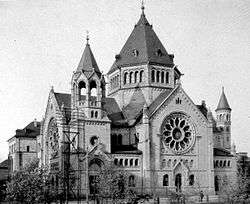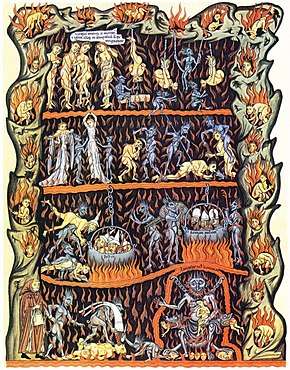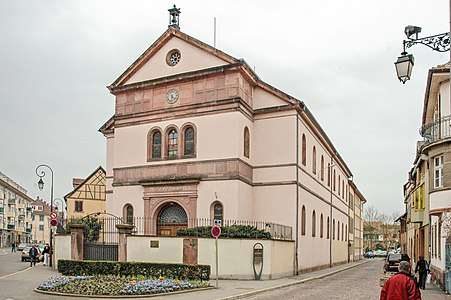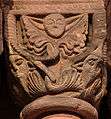History of the Jews in Alsace
The history of the Jews in Alsace is one of the oldest in Europe. It was first attested to in 1165 by Benjamin of Tudela, who wrote about a "large number of learned men" in "Astransbourg";[2] and it is assumed that it dates back to around the year 1000.[3] Although Jewish life in Alsace was often disrupted by outbreaks of pogroms, at least during the Middle Ages, and reined in by harsh restrictions on business and movement, it has had a continuous existence ever since it was first recorded. At its peak, in 1870, the Jewish community of Alsace numbered 35,000 people.[4]

| Part of the series on |
| Alsace |
|---|
Rot un Wiss, traditional flag of Alsace |
|
|
|
|
|
Alsace in the European Union |
|
Related topics |
Language and origins
The language traditionally spoken by the Jews of Alsace was Judeo-Alsatian (Yédisch-Daïtsch),[5] originally a mixture of Middle High German, Old Alsatian, Medieval Hebrew and Aramaic, and largely indistinguishable from Western Yiddish. From the 12th century onwards, due among other things to the influence of the nearby Rashi school, French linguistic elements were incorporated as well; and from the 18th century onwards, due to immigration, some Polish elements were blended into Yédisch-Daïtsch too.[6]
Medieval antisemitism and massacre of 1349

Several disparaging representations of Jews in medieval Alsatian art, usually showing them with the characteristic three-pointed hat, have survived and can still be seen in situ, notably on the tympanum of the Romanesque Église Saints-Pierre-et-Paul in Sigolsheim, on the roof of the Église Saints-Pierre-et-Paul in Rosheim and the Église Saint-Léger in Guebwiller (both Romanesque as well, and showing a seated Jew holding a money purse), on Strasbourg Cathedral and on the gothic Collégiale Saint-Martin in Colmar, which shows no fewer than two different representations of a Judensau. Other medieval representations have survived through copies of the Hortus deliciarum and as architectural fragments in the Musée de l’Œuvre Notre-Dame.[7] Stained glass windows in the Niederhaslach Church, frescoes in the Église Saint-Michel of Weiterswiller and a tapestry in the Église Saints-Pierre-et-Paul of Neuwiller-lès-Saverne also show disparaging representations of Jews in traditional attire.[8]
In 1286, Rabbi Meir of Rothenburg, one of the leading Jewish figures of his day, was imprisoned by the German king in a fortress near Ensisheim.
In 1349, Jews of Alsace were accused of poisoning the wells with plague. On February 14, Saint Valentine's day, several hundred Jews were massacred during the Strasbourg pogrom.[9] Jews were subsequently forbidden to settle in the town and were reminded every evening at 10 o'clock by a Cathedral bell and a municipal herald blowing the "Grüselhorn" to leave. Alsatian Jews then settled in the neighbouring villages and small towns, where many of them became cloth merchants ("Schmatteshendler") or cattle merchants ("Behemeshendler").
Early modern times
An important political figure for the Jews of Alsace and beyond was the long-serving "shtadlan" Josel of Rosheim. In 1510 he was made the parnas u-manhig (sworn guide and leader) of the Jewish communities of Lower Alsace, before becoming the German Emperor's favourite interlocutor on Jewish matters and the most influential intercessor on the Jews' behalf.
French rule until 1871
With the annexation of Alsace to France in 1681, Catholicism was restored as the principal Christian current. However, the prohibition against Jews settling in Strasbourg, and the special taxes Jews were subjected to, were not lifted. In the 18th century, Herz Cerfbeer of Medelsheim, the influential merchant and philanthropist, became the first Jew to be allowed to settle in the Alsatian capital again. The French Revolution then admitted Jews back into the town.
By 1790, the Jewish population of Alsace was approximately 22,500, about 3% of the provincial population. Another 7500 Jews lived in neighboring Lorraine. Together they comprised three-fourths of the 40,000 Jews who lived in France at the time. The Jews were highly segregated, subject to long-standing anti-Jewish regulations. They maintained their own customs, language, and historic traditions within the tightly-knit ghettos; they adhered to Talmudic law enforced by their rabbis. Jews were barred from most cities and instead lived in hundreds of small hamlets and villages. They were also barred from most occupations, and concentrated in trade, services, and especially in moneylending. They financed about a third of the mortgages in Alsace. Leading philosophers of the French Enlightenment, such as Denis Diderot and Voltaire, ridiculed and condemned French Jews as misanthropic, rapacious, and culturally backward. In 1777, a local judge forged hundreds of receipts, which he gave to Catholic peasants, to "prove" they had repaid their debts to Jewish moneylenders. The Jews protested, and a Prussian official, Christian Wilhelm von Dohm, wrote a highly influential pamphlet "On the Civic Improvement of the Jews" (1781), which advanced the cause of Jewish emancipation in both Germany and France.
Religious tolerance grew during the French Revolution, with full emancipation given to Protestants in 1789, Sephardic Jews in 1790, and the Ashkenazi Jews of Alsace and Lorraine in 1791. When Napoleon created the "Grand Sanhedrin" in 1806, he appointed the Chief Rabbi of Strasbourg, Joseph David Sinzheim, as its first President. However, local antisemitism also increased, and Napoleon turned hostile in 1806, imposing a moratorium on repaying all debts owed to Jews. In 1808 Napoleon imposed tight limits on Jewish money-lending, capping interest rates at 5%. Napoleon's decrees collapsed after he fell from power, but an undercurrent of antisemitism remained. In the 1830–1870 era, urban middle-class Jews made enormous progress toward integration and acculturation, as antisemitism sharply declined. By 1831, the state began paying salaries to official rabbis, and in 1846 a special oath required for Jews in court was discontinued. Antisemitic riots occasionally occurred, especially during the Revolution of 1848. In 1854, Isaac Strauss became director of the orchestra of the bals de l'Opéra and then of the bals des Tuileries, before the empress Eugénie de Montijo replaced him with Émile Waldteufel in 1867. During this era before 1870 many Jews converted to Christianity, including David Paul Drach (1823), Francis Libermann (1826) and Alphonse Ratisbonne (1842). After Alsace was incorporated into Germany in 1871 (until 1918) antisemitic violence diminished.[10]
Dreyfus affair

While the Dreyfus affair (1894–1906) by and large played out in France, and Alsace was a part of Germany at the time, it had immediate repercussions for the Jews in Alsace. Alfred Dreyfus was by birth a citizen of Mulhouse and thus suspected by French conservatives of innate sympathy with the German enemy by virtue of his being Alsatian and Jewish, which put him under suspicion of being doubly disloyal. One of the alleged traitor's strongest advocates was fellow Mulhousian Auguste Scheurer-Kestner, a (non-Jewish) chemist, industrialist, politician and philanthropist.[11] Another main player in the Affair, and advocate of Dreyfus' cause, was the Strasbourg-born army general Georges Picquart.
1940–1945
World War II started in September, 1939. In May, 1940 Germany invaded and defeated France. Under the terms of the Armistice of 22 June 1940, Alsace became part of the German occupation zone.[12]
In 1939, there were about 20,000 Jews living in Alsace and Lorraine. Evacuation of Alsace and Lorraine was started by the French government already on 3 September 1939, which was immediately following the start of World War II. About 14,000 Jews were evacuated to Périgueux and Limoges in southwest France, and far from the German border. About 5,000 more Jews fled to southern France after the German invasion of France in May, 1940.[13][14] On 15 July 1940, most of the remaining Alsatian Jews (about 3,000) were evicted from their homes by the German authorities and deported to Vichy France.[15] The Germans declared Alsace and Lorraine to be Judenrein (lit: cleansed of Jews).[16]
During World War II, Germany established the Natzweiler-Struthof concentration camp in Alsace. August Hirt became an institute director at the Nazi University of Strasbourg; he is notorious for his experiments with concentration camp prisoners and for his efforts to establish a Jewish skeleton collection.
Many Alsatian Jews who had been relocated to western regions of the country were ultimately arrested and deported. It is estimated that 2,605 Jews from Bas-Rhin[17] and 1,100 from Haut-Rhin[18] were murdered during the Holocaust.
Businessmen such as Théophile Bader, founder of the Galeries Lafayette; Pierre Wertheimer, founder of the French cosmetics company Bourjois and partner of Coco Chanel; and Albert Kahn, banker and philanthropist would have faced confiscation of their properties and/or deportation to a death camp if they had not managed to flee in time.
Jews in Alsace today
There were about 50,000 Jews in Alsace in 1970.[19]
After the Algerian war, beginning in 1962, Sephardic Jews arrived in Alsace from North Africa. In the year 2000, roughly 4,000 Jews in Strasbourg were Sephardic, making up a little over 25% of the total Jewish population.[20] In the year 2001, roughly 25% of the 500 Jewish families of Mulhouse were Sephardic.[21]
Presentation of Alsatian Jewish history and heritage
A presentation of the Alsatian Jews's history and culture through collections of artifacts and architectural elements can be found in the Musée Judéo-Alsacien of Bouxwiller, Bas-Rhin, in the Musée du bain rituel juif (Mikvah museum) of Bischheim, in the Musée alsacien and the Musée historique of Strasbourg, in the Musée historique of Haguenau, in the Musée d'Arts et Traditions Populaires of Marmoutier, in the Musée du vieux Soultz of Soultz-Haut-Rhin, in the Musée du pays de la Zorn of Hochfelden, in the Musée de l'image populaire of Pfaffenhoffen and in the Musée Bartholdi of Colmar.[23]
The annual European Day of Jewish Culture was initiated in 1996 by the B'nai Brith of Bas-Rhin together with the local Agency for Development of Tourism.[24] It now takes place in 27 European countries including Turkey and Ukraine.[25] The original aim of the day was to permit access to, and ultimately encourage restoration of, long-abandoned synagogues of architectural value such as those in Wolfisheim, Westhoffen, Pfaffenhoffen, Struth, Diemeringen, Ingwiller and Mackenheim.
Notable Jews born in Alsace
- Liliane Ackermann
- Théophile Bader
- Hans Bethe
- Gustave Bloch
- Moses Bloom
- Marcelle Cahn
- David Léon Cahun
- Isaachar Bär ben Judah Carmoly
- Herz Cerfbeer of Medelsheim
- Debré family
- Alfred Dreyfus
- Louis Dreyfus family
- Javal family
- Josel of Rosheim
- Albert Kahn (banker)
- Alphonse Kahn (born in Kolbsheim), co-founder of the Galeries Lafayette (with Théophile Bader, see above)[26]
- Zadoc Kahn
- Maurice Kriegel-Valrimont
- Friedrich Wilhelm Levi
- Alphonse Lévy (1843-1918, born in Marmoutier), painter[27]
- Maurice Lévy
- Francis Libermann
- Isidore Loeb
- Marcel Marceau
- Sam Marx
- Charles Netter
- Marie-Alphonse Ratisbonne
- Camille Sée
- Isaac Strauss (1806–1888), conductor and arts collector[28]
- Benjamin Ulmann
- Claude Vigée
- Pierre Villon
- Vivelin the Red
- Émile Waldteufel
- Alexandre Weill (1811–1899), writer[28]
- Cora Wilburn
- Robert Wyler
- William Wyler
Gallery
- Museum of Alsatian Judaism in former Synagogue (1842), Bouxwiller, Bas-Rhin
- Synagogue of Haguenau (1820)
 Synagogue of Colmar (1839)
Synagogue of Colmar (1839)- Synagogue of Mulhouse (1848)
- Synagogue of Bergheim, Haut-Rhin (1863)
- Synagogue of Sélestat (1890)
- Synagogue of Wolfisheim (1897)
- Synagogue of Saverne (1900)
- Synagogue of Wissembourg (1960)
 Romanesque capital in Sigolsheim showing Jews with characteristic hats on each lower corner
Romanesque capital in Sigolsheim showing Jews with characteristic hats on each lower corner- "The Jew with a money purse" in Rosheim
See also
References
- La synagogue consistoriale du quai Kléber (in French)
- Les Juifs à Strasbourg au Moyen âge (in French)
- Histoire des Juifs d'Alsace (in French)
- Histoire et mémoire des Juifs d'Alsace : recherches actuelles (in French)
- Yédisch-Daïtsch, le dialecte judéo-alsacien (in French)
- Structure du parler judéo-alsacien (in French)
- All referenced in: Assall, Paul (1984). Juden im Elsass (in German). Moos: Elster Verlag. ISBN 3-89151-000-4. OCLC 12975374.
- L'iconographie ou les Juifs par l'image (in French)
- Sherman, Irwin W. (2006). The power of plagues. Wiley-Blackwell. p. 74. ISBN 1-55581-356-9.
- Vicki Caron, "Alsace," in Richard S. Levy, ed., Antisemitism: A historical Encyclopedia of prejudice and persecution (2005) 1:13-16
- Auguste Scheurer-Kestner (1833 - 1899) (in French)
- Unlike most of the German occupied region of France, Alsace was effectively annexed by Germany by 1942, when Alsatians became German citizens by decree, and Alsace formally became part of the administrative unit (Gau) of Baden-Elsaß. See Jäckel, Eberhard (1966). "L'annexion déguisée". Frankreich in Hitlers Europa – Die deutsche Frankreichpolitik im Zweiten Weltkrieg (in French). Stuttgart: Deutsche Verlag-Anstalg GmbH. pp. 123–124.
- "Alsace-Lorraine" (PDF). Shoah Resource Center, The International School for Holocaust Studies. Retrieved 2017-03-04.
- Lazare, Lucien. "Limoges et Périgueux, refuges des Juifs de Strasbourg sous l'Occupation" (in French). Le judaïsme d'Alsace et de Lorraine.
- Dwork, Deborah; Pelt, Robert Jan van (2003). Holocaust: A History. W. W. Norton & Company. p. 234. ISBN 9780393325249.
- Schwarzfuchs, Simon. "Le 15 juillet 1940 : La dernière expulsion des Juifs d'Alsace" (in French).
- Gutman, René. "Le Memorbuch, mémorial de la déportation et de la résistance des Juifs du Bas-Rhin" (in French). Le judaïsme d'Alsace et de Lorraine.
- "Le Mémorial des Juifs du Haut-Rhin" (in French). Le judaïsme d'Alsace et de Lorraine.
- Blumenkranz, Bernhard; Catane, Moshe (2007). "Alsace". Encyclopaedia Judaica (2 ed.). Thomson Gale.
- "Souviens-toi de l'Oratoire Leo Cohn" (in French)
- La communaute juive de Mulhouse aujourd'hui (in French)
- The synagogue of Ingwiller (in French)
- "List of Alsatian museums displaying Jewish heritage". Archived from the original on 2007-10-28. Retrieved 2009-03-23.
- European Day of Jewish Culture 2007 Archived 2011-09-27 at the Wayback Machine
- jewishheritage.org Archived 2011-07-26 at the Wayback Machine
- Théophile Bader, fondateur des Galeries Lafayettes, de Dambach-la-Ville au Boulevard Haussmann (in French)
- Alphonse Lévy 1843-1918 (in French)
- Regards sur la culture judéo-alsacienne Éditions La Nuée bleue/DNA, Strasbourg, 2001, ISBN 2-7165-0568-3
Further reading
- Caron, Vicki (1988). Between France and Germany: The Jews of Alsace-Lorraine, 1871-1918.
- Dreyfus, Jean-Marc (2015). "Alsace-Lorraine". In Gruner, Wolf; Osterloh, Jörg (eds.). The Greater German Reich and the Jews: Nazi Persecution Policies in the Annexed Territories 1935-1945. Bernard Heise (translator). Berghahn. pp. 316–339. ISBN 978-1782384434. OCLC 903803958.
- Halff, Sylvain (September 13, 1920 – October 2, 1921). "The Jews of Alsace-Lorraine (1870–1920)". The American Jewish Year Book. American Jewish Committee: 53–79. JSTOR 23601103. The recovery of Alsace by France was nevertheless welcomed by a majority of the Jews living there. Even some former representatives of Alsace in Berlin were incorporated into the French democracy and decorated by the French government.
- Hyman, Paula E. (1991). The Emancipation of the Jews of Alsace: Acculturation and Tradition in the Nineteenth Century.
External links
| Wikimedia Commons has media related to Judaism in Alsace. |

